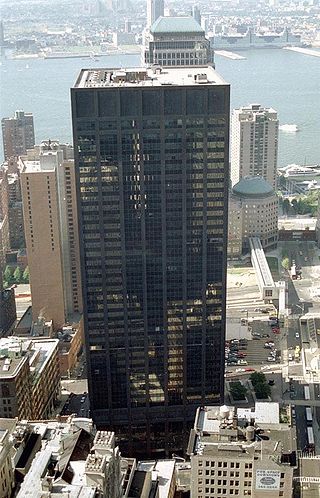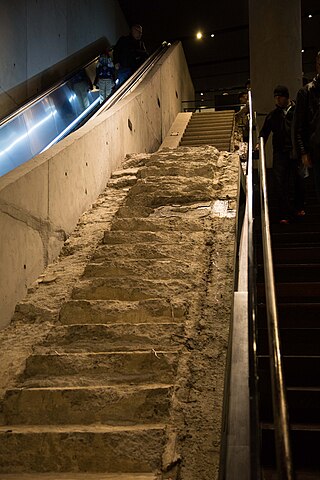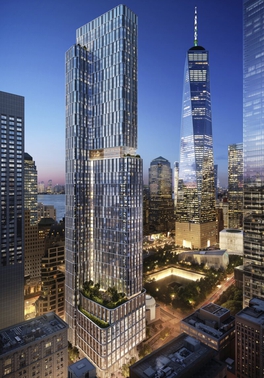
The World Trade Center site, often referred to as "Ground Zero" or "the Pile" immediately after the September 11 attacks, is a 14.6-acre (5.9 ha) area in Lower Manhattan in New York City. The site is bounded by Vesey Street to the north, the West Side Highway to the west, Liberty Street to the south, and Church Street to the east. The Port Authority of New York and New Jersey (PANYNJ) owns the site's land. The original World Trade Center complex stood on the site until it was destroyed in the September 11 attacks.

7 World Trade Center is an office building constructed as part of the new World Trade Center in Lower Manhattan, New York City. The tower is located on a city block bounded by Greenwich, Vesey, Washington, and Barclay Streets on the east, south, west, and north, respectively. 7 World Trade Center was developed by Larry Silverstein, who holds a ground lease for the site from the Port Authority of New York and New Jersey, and designed by Skidmore, Owings & Merrill.

The World Trade Center in New York City collapsed on September 11, 2001, as result of the al-Qaeda attacks. Two commercial airliners hijacked by al-Qaeda terrorists were deliberately flown into the Twin Towers of the complex, resulting in a total progressive collapse that killed almost 3,000 people. It is the deadliest and most costly building collapse in history.

The Marriott World Trade Center was a 22-story, 825-room hotel within the World Trade Center complex in Manhattan, New York City. It opened in April 1981 as the Vista International Hotel and was the first major hotel to open in Lower Manhattan south of Canal Street since 1836. It was also unofficially known as World Trade Center 3, and the World Trade Center Hotel, officially the Vista Hotel, and the Marriott Hotel throughout its history.

6 World Trade Center was an eight-story building in Lower Manhattan in New York City. It opened in 1974 and was the building in the World Trade Center complex that had the fewest stories. The building served as the U.S. Customs House for New York. It was demolished in late 2001 due to the damage from the collapse of the North Tower during the September 11 attacks. Its site is now the location of the new One World Trade Center and the Perelman Performing Arts Center.

The Deutsche Bank Building was a 39-story office building located at 130 Liberty Street in Manhattan, New York City, adjacent to the World Trade Center site. The building opened in 1974 and closed following the September 11 attacks in 2001, due to contamination that spread from the collapse of the South Tower. The structure was designed by Shreve, Lamb & Harmon, which also designed the Empire State Building.

One Liberty Plaza, formerly the U.S. Steel Building, is a skyscraper in the Financial District of Lower Manhattan in New York City. It is situated on a block bounded by Broadway, Liberty Street, Church Street, and Cortlandt Street, on the sites of the former Singer Building and City Investing Building.

One World Trade Center, also known as One World Trade, One WTC, and formerly called the Freedom Tower during initial planning stages, is the main building of the rebuilt World Trade Center complex in Lower Manhattan, New York City. Designed by David Childs of Skidmore, Owings & Merrill, One World Trade Center is the tallest building in the United States, the tallest building in the Western Hemisphere, and the seventh-tallest in the world. The supertall structure has the same name as the North Tower of the original World Trade Center, which was destroyed in the terrorist attacks of September 11, 2001. The new skyscraper stands on the northwest corner of the 16-acre (6.5 ha) World Trade Center site, on the site of the original 6 World Trade Center. It is bounded by West Street to the west, Vesey Street to the north, Fulton Street to the south, and Washington Street to the east.

The Survivors' Staircase was the last visible remaining original structure above ground level at the World Trade Center site. It was originally an outdoor flight of granite-clad stairs and two escalators which connected Vesey Street to the World Trade Center's Austin J. Tobin Plaza. During the September 11 attacks, the stairs served as an escape route for hundreds of evacuees from 5 World Trade Center, a 9-floor building adjacent to the Twin Towers. The staircase is now an important feature of the National September 11 Memorial & Museum.

Some conspiracy theories contend that the collapse of the World Trade Center was not solely caused by the airliner crash damage that occurred as part of the September 11 attacks, and the resulting fire damage, but by explosives installed in the buildings in advance. Controlled demolition theories make up a major component of 9/11 conspiracy theories.

The construction of the first World Trade Center complex in New York City was conceived as an urban renewal project to help revitalize Lower Manhattan spearheaded by David Rockefeller. The project was developed by the Port Authority of New York and New Jersey. The idea for the World Trade Center arose after World War II as a way to supplement existing avenues of international commerce in the United States.

5 World Trade Center is a planned skyscraper at the World Trade Center in Lower Manhattan, New York City. The site is across Liberty Street, to the south of the main 16-acre (6.5 ha) World Trade Center site. In February 2021 it was announced the new 5 World Trade Center will be developed in a joint venture between Silverstein Properties and Brookfield Properties. The proposed building shares its name with the original 5 World Trade Center, which was heavily damaged as a result of the collapse of the North Tower during the September 11 attacks and was later demolished.

Progressive collapse is the process where a primary structural element fails, resulting in the failure of adjoining structural elements, which in turn causes further structural failure.

2 World Trade Center is a skyscraper being developed as part of the rebuilt World Trade Center complex in Manhattan, New York City. It will replace the original 2 World Trade Center, which was completed as part of the first World Trade Center in 1973 and subsequently destroyed during the September 11 attacks in 2001, and it will occupy the position of the original 5 World Trade Center. The foundation work was completed in 2013, though no construction has taken place since.

The original World Trade Center (WTC) was a large complex of seven buildings in the Financial District of Lower Manhattan in New York City. It opened on April 4, 1973, and was destroyed during the September 11 attacks in 2001. At the time of their completion, the Twin Towers—the original 1 World Trade Center at 1,368 feet (417 m), and 2 World Trade Center at 1,362 feet (415.1 m)—were the tallest buildings in the world. Other buildings in the complex included the Marriott World Trade Center, 4 WTC, 5 WTC, 6 WTC, and 7 WTC. The complex contained 13,400,000 square feet (1,240,000 m2) of office space and, prior to its completion, was projected to accommodate an estimated 130,000 people.

The NIST World Trade Center Disaster Investigation was a report that the National Institute of Standards and Technology (NIST) conducted to establish the likely technical causes of the three building failures that occurred at the World Trade Center following the September 11, 2001 terrorist attacks. The report was mandated as part of the National Construction Safety Team Act, which was signed into law on October 1, 2002 by President George W. Bush. NIST issued its final report on the collapse of the World Trade Center's twin towers in September 2005, and the agency issued its final report on 7 World Trade Center in November 2008.

4 World Trade Center was a nine-story low-rise office building completed in 1975 that was 118 ft tall, and located in the southeast corner of the World Trade Center complex in Lower Manhattan, New York City. The building was designed by Minoru Yamasaki and Emery Roth & Sons. On September 11, 2001, the building was heavily damaged as a result of attacks carried out by the Islamic terrorist group Al-Qaeda, and was later demolished. Its site is now the location of 3 World Trade Center and a new 4 World Trade Center.

7 World Trade Center, colloquially known as Building 7, was an office building constructed as part of the original World Trade Center Complex in Lower Manhattan, New York City. The tower was located on a city block bounded by West Broadway, Vesey Street, Washington Street, and Barclay Street on the east, south, west, and north, respectively. It was developed by Larry Silverstein, who held a ground lease for the site from the Port Authority of New York and New Jersey, and designed by Emery Roth & Sons. It was destroyed during the September 11 attacks.






















